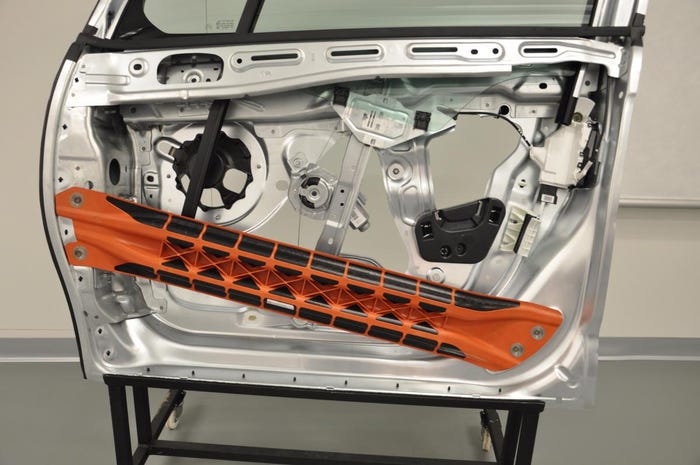DuPont is making a new push into thermoplastic composites as part of its global strategy to develop technologies that reduce emphasis on fossil fuels, corporate officials said in interviews at the company's Chestnut Run complex in Delaware last week.
June 27, 2013
DuPont is making a new push into thermoplastic composites as part of its global strategy to develop technologies that reduce emphasis on fossil fuels, corporate officials said in interviews at the company's Chestnut Run complex in Delaware last week.
"We're looking at designs that can provide structure in a car while also reducing weight...Our goal is to develop automotive composites that can be produced in cycle times of less than one minute," said David A. Glasscock, DuPont's global business manager of thermoplastic composites. That's a significant improvement over conventionally used thermoset composites, which often have cycle times of many minutes.
|
TP composite provides strength at big weight savings. |
DuPont has a long history in the development of thermoplastic composites, and some of the assets are no longer part of the company.
Tepex spinoff
For example, the Tepex family of thermoplastic composites was created in the early 1990s in the research laboratories of DuPont. In 1997 two materials experts who participated in the development process acquired the technology. Their company is called Bond Laminates (Brilon, Germany) and is a leading developer of advanced composites. Lanxess, a Bayer spin-off, now owns the company.
One impressive example of DuPont's new research push will be on display this fall at K 2013 (Düsseldorf, Germany, Oct. 16-23).
A side impact beam made of nylon 6,6 and woven glass laminate reduces weight 60%, according to Glasscock. The composite is 63% glass by weight. DuPont is also testing beams made with carbon fiber that reduce weight even further.
DuPont's research partner is PSA Peugeot Citroën, which has launched a sustainability program that also includes significant use of renewably resourced plastics and reinforcements.
Targets EU emissions law
"In order to be one of the first car manufacturers to comply with the 95 grams per kilometer of C02 emissions 2020 regulation, PSA Peugeot Citroën are carrying out a number of R&D projects focusing on powertrain and performance in low-emission vehicles," said Stephane Delalande, an engineer specializing in plastic and composites at PSA Peugeot Citroën. "One of the key research directions is the reduction of vehicle mass, with the goal of reducing total weight by at least 200 kg between 2020 and 2025. For this reason, increasing the use of composite materials constitutes a breakthrough solution to continue leading the way in controlling emissions.'
Delalande, a PhD, is leader of the StelLab network at PSA Peugeot Citroën. He spoke at a pre-K conference held by DuPont in Europe earlier this month. The parts will be used on future PSA cars, but specific details were not disclosed. DuPont showed the part at JEC Paris in March.
In the meeting in Delaware, Glasscock said that composite sheet is first stamped and then overmolded with a network of ribs. The composite beam is incorporated into the body in white prior to the online painting process, also known as E-coat.
'We don't know yet'
Other automotive materials technology at the DuPont booth at K 2013 include:
Vamac ULTRA LS designed for very low swell performance in oil seals will be commercialized at the show.
Crastin HR HFS PBT is a second generation polybutylene terephthalate (PBT) targeting connectors in electric or hybrid electric vehicles. It is said to combine improved hydrolysis resistance with dimensional stability and easy processing.
A third generation Zytel PLUS nylon improves on the air oven ageing and property retention performance of nylon 6,6, but also pushes the in-use temperature limits of nylon to meet the high temperature challenges of the industry. Asked what the thermal limit is for nylon 6,6 under the hood, DuPont Technology VP Lewis Manring said: "We don't know yet."
You May Also Like



